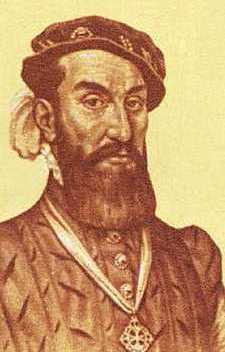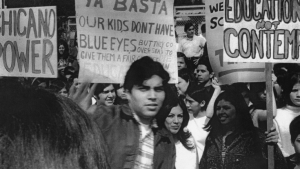The stories of the Spanish conquistadors, of men that believed themselves to be conquerors fighting and exploring for God and gold, are well known. While many of those conquistadors may have seen themselves as bringing civilization to a savage new land, there are those who would argue that this is an incorrect way to view the conquistadors. Instead, they would claim that the conquistadors were encroaching on other people’s culture and religion. One would-be conquistador ended up having a much different experience than most, an experience so different that it forced him to view the Native Americans in a new light, so much so that he eventually advocated for them. This man’s name was Alvar Nunez Cabeza de Vaca.
Cabeza de Vaca was born to a Spanish noble family in 1492. When he was young, his parents died, and he was forced to live with some other relatives. In 1521, he joined the army as an officer after distinguishing himself during military conflict in Italy. In 1527, Cabeza de Vaca embarked on an expedition to explore modern-day Florida, one led by Pánfilo de Narváez. His role in this expedition was that of treasurer for the colony.1 In addition to this, he was also ordered to let the king know of any injustices done by the Spaniards to the Native Americans. The nature of his duty did not change the way that Cabeza de Vaca viewed the Native Americans. At the beginning of the expedition, he still viewed them mainly as savages that were primarily in opposition to Spanish goals. Any respect, if any, that he gave to them was purely that of a rival in regards to their fighting ability.2 This initial attitude would end up standing in very stark contrast to the way that Cabeza de Vaca would eventually come to view them.

The beginning of the Narváez expedition was not off to a great start. Narváez imagined himself as the next Cortez and wanted to follow his example and find a city full of gold. In order to do this, Narváez had decided to pursue rumors of a city of gold, known to the natives only as “Apalachee,” instead of staying closer to the shoreline and their supplies. Narváez was hoping that he would be able to make an endless amount of wealth by conquering this civilization, but when he finally arrived on the shore, all that he and his men found was a small Native American village.3 After this accident, the expedition attempted to meet up with their ship to resupply, but the ship never arrived. It was then that Narváez decided that the crew would make their own ships and sail towards Mexico, hoping to link up with any Spanish forces in the area.4 At this point in the expedition, many of the remaining members, including Cabeza de Vaca, were convinced that their deaths were close and that their situation was dire. At one point, Narváez himself decided to abandon the other ships and survivors in favor of saving his skin. This would be the last time that Cabeza de Vaca, or anyone, would see the would-be conquistador. At the end of it all, there ended up being less than one hundred men left in the expedition, and they all eventually landed on an island that they decided to call “Malhado,” or “Misfortune.” Today, we now know this area as Galveston Island.5
It was on this island that Cabeza de Vaca first encountered the Native Americans in a new light. It was here that a group of Native Americans provided food and shelter to Cabeza de Vaca and his company. Not all of the members of the expedition took advantage of the kindness that was shown to them, however. While many were unable to trust the Native Americans, it was his willingness to trust the Native Americans that most likely saved Cabeza de Vaca’s life, as most of those who did not take their offer ended up dead. After spending the winter on the island, there were only sixteen remaining members of the expedition.6 The entire scenario was a new experience for Cabeza de Vaca, as the only way he had ever viewed the Native Americans before was as rivals. But, much to his amazement, they showed undying compassion and empathy for a group of men that they did not know. Although he originally thought that rescue was coming within a year, Cabeza de Vaca’s experience on the small island was just the beginning of what would happen to him while he lived with the Native Americans.

Cabeza de Vaca would go on to live on Malhado for about four more years while serving as a physician and trader to the tribes there. He realized that his only real chance for survival during this time was to make himself useful to the tribe. Although he had originally refused to become a healer, due to the fact that he viewed the Native American way of healing similar to idolatry, he eventually caved and started to learn their ways of healing due to necessity. He would go on to learn much about Native American culture, not because he was curious, but rather, he was forced to so in order to survive. He learned Native American languages, customs, and what items were valuable to the Native American lifestyle.7 Learning all of these skills ultimately allowed Cabeza de Vaca to survive his experience on Malhado. Over the years, Cabeza de Vaca had to get a new understanding of Native American culture as he was exposed to parts of their lives that he had never even bothered to think about before. This is also when Cabeza de Vaca most likely began embracing the different culture. When he got the opportunity, Cabeza de Vaca focused on writing many of his observations about the Native Americans, mainly on how they worked as a group and not on their individual lives. Indeed, he focused on what they did as a culture and economically above all else. This was most likely the result of the lens of mercantilism through which he often viewed the world, as it was one of the prevailing economic policies in Europe and the region that he was from.8
During his four years there, Cabeza de Vaca also met up with a few of his fellow members from the expedition that were doing similar work with other tribes, Dorantes, Estevanico, and Castillo. These three men were his main connections to his life before living in Malhado. Eventually, Cabeza de Vaca and these men decided on a gamble to leave the island in order to escape from the roles that they had been forced into during their time with the tribes. They made their escape, and, after a few days, were welcomed by a tribe on the condition that they help the tribe as healers. This predicament simply placed the men in the same situation they were in earlier. Nevertheless, they worked as healers to ensure their survival, and these men attributed any of the healing that they performed to God, as they themselves regarded any healing as a miracle.9 It was around this time that Cabeza de Vaca truly seemed to have become sympathetic to the Native Americans. Although he became genuinely worried about their well-being, he still often took offers of wealth from the tribe, and later painted himself and the other Spaniards as saviors to the Native Americans.10
Cabeza de Vaca and the others eventually found themselves well-respected by the Native Americans, and they used that fact to their advantage. In addition to accepting gifts from the tribe, they also asked the Native Americans to bring them to certain places that they wished to go. This may have started as manipulation, but after a while, Cabeza de Vaca focused on using this newfound respect to teach the Native Americans about God.11 Cabeza de Vaca and his compatriots continued to do this until they encountered a group of Spaniards near Mexico. When they finally made contact, Cabeza de Vaca quickly realized that there was a fundamental difference in the way that the Native Americans perceived him and how they perceived the other Spaniards. That is, they regard him as a man who gives back as opposed to one who takes. He also noticed that his view of the Native Americans greatly differed from that of his his fellow countrymen.12 He greeted his fellow Spaniards, and, after some negotiation, they finally decided to send him to Mexico where he rested for a while before returning to Spain.13

When Cabeza de Vaca returned to Spain, he started to write down what had happened to him during his time in the New World. In these accounts, he described his unique experiences with the Native Americans, including their treatment of him and how he worked with them in order to ensure his survival. As a result of his encounter, he was appointed the governor of a province in South America. While there, he tried to treat the Natives with respect, due to his experiences earlier in life. This policy, however, ended up upsetting many of the people he governed, and he was eventually sent back to Spain, where he lost the respect of the Spanish government. Nearing the end of his life, he ended up staying there until he died a broke man with little respect.14 Cabeza de Vaca led an amazing life, and, although it ended in a very non-climatic way, it was nevertheless one filled to the brim with moral and philosophical lessons. The story of Cabeza de Vaca is one that we should learn from: it is a great account of how cultural exchange can change the way that we see people from other cultures.
- Nan Goodman, “Mercantilism and Cultural Difference in Cabeza de Vaca’s ‘Relación,’” Early American Literature 40, no. 2 (2005): 236. ↵
- Mary Doctor, “Enriched by Otherness: The Transformational Journey of Cabeza de Vaca,” Christianity & Literature 58, no. 1 (2008): 8. ↵
- Mary Doctor, “Enriched by Otherness: The Transformational Journey of Cabeza de Vaca,” Christianity & Literature 58, no. 1 (2008): 8. ↵
- “Cabeza de Vaca, Alvar Núñez (1492?-1559?),” American Eras, 50-51. Vol. 1, Early American Civilizations and Exploration to 1600, (Detroit, MI: Gale, 1997), 51. ↵
- Carlos A. Jáuregui, “Going Native, Going Home: Ethnographic Empathy and the Artifice of Return in Cabeza de Vaca’s Relación,” Colonial Latin American Review 25, no. 2 (2016): 181. ↵
- Carlos A. Jáuregui, “Going Native, Going Home: Ethnographic Empathy and the Artifice of Return in Cabeza de Vaca’s Relación,” Colonial Latin American Review 25, no. 2 (2016): 181. ↵
- Mary Doctor, “Enriched by Otherness: The Transformational Journey of Cabeza de Vaca.” Christianity & Literature 58, no. 1 (2008): 13. ↵
- Nan Goodman, “Mercantilism and Cultural Difference in Cabeza de Vaca’s ‘Relación,’” Early American Literature 40, no. 2 (2005): 231. ↵
- Mary Doctor, “Enriched by Otherness: The Transformational Journey of Cabeza de Vaca,” Christianity & Literature 58, no. 1 (2008): 14. ↵
- Mary Doctor, “Enriched by Otherness: The Transformational Journey of Cabeza de Vaca,” Christianity & Literature 58, no. 1 (2008): 16. ↵
- Mary Doctor, “Enriched by Otherness: The Transformational Journey of Cabeza de Vaca,” Christianity & Literature 58, no. 1 (2008): 17-18. ↵
- Nan Goodman, “Mercantilism and Cultural Difference in Cabeza de Vaca’s ‘Relación,’” Early American Literature 40, no. 2 (2005): 247. ↵
- “Cabeza de Vaca, Alvar Núñez (1492?-1559?),” American Eras, 50-51. Vol. 1, Early American Civilizations and Exploration to 1600, (Detroit, MI: Gale, 1997), 51. ↵
- “Cabeza de Vaca, Alvar Núñez (1492?-1559?),” American Eras, 50-51. Vol. 1, Early American Civilizations and Exploration to 1600, (Detroit, MI: Gale, 1997), 51. ↵



97 comments
Auroara-Juhl Nikkels
The ending to Cabeza de Vaca’s life was not one I was expecting. To have lived such a different life than those of other conquistadors, to have gained the respect of Native Americans in spite of what his countrymen did to them, and then to have died with no respect, is not a twist that I saw coming. You did a great job telling us the story of this man’s life!
Chelsea Alvarez
Learning about the Spanish conquistadors is something that is taught early into middle school, but I had never read so much in-depth information on it. This article’s research was very well put together since the story was cohesive and easy to understand. I admire Cabeza de Vaca’s ideology behind living communally with Native Americans rather than killing or pushing them to other territories. He was smart in being friendly to the indigenous people, since they had far more knowledge of the land and how to successfully survive in it. Congratulations on your nomination!
Victoria Salazar
This is a great article. I liked it because part of the article focuses on Cabeza de Vaca’s understanding and acceptance that we need in today’s world. Cabeza de Vaca is a prime example of “people do not like what they do not understand.” He went from judging the Native Americans’ way of life, to observing it so that he could understand it. The domestic and international racism and hate in today’s world could be reduced if we all took a moment to understand one another.
Sharriah Martinez
I have never heard about Cabeza de Vaca.I was shocked to know that he had a transformation with the Native americans. Cabeza de Vaca changed the way he saw native americans after he spent time living with them for a couple years. He had survival skills and taught his skills to others which i thought was interesting. Thank you for showing me about his life and where he stands with the native Americans and their culture/ life. Congrats on your nomination it was well deserved.
Dalton Moy
Nice Article! It was great that Cabeza de Vaca had a change of heart about the Native Americans. It was sad to see that his reformed views were not shared. I wish the government would have supported the natives more. I also wish that Cabeza’s change of heart would not have caused people to dislike him.
Mariah Garcia
Very interesting article! I did not know much about the Spanish Conquistadors, so when reading this article I was very interested to learn about information of the Spanish Conquistadors. Especially Cabeza de Vaca and how he stood up for the Native Americans because rather than conquering he wanted to live amongst them. This was a story I didn’t expect from a Spanish Conquistador because he wasn’t the stereotypical Conquistador, he admired the Native American lives and cherish what they had.
Hali Garcia
Great article! It has been awhile since I have learned about Cabeza de Vaca and your article really gives me a short overview of what he has done. What struck me about this article was how Cabeza de Vaca adapted and used the Native American’s culture to help out instead of just trying to conquer them. Great job and congratulations on your nomination!!!
Sarah Uhlig
I remember reading about Cabeza de Vaca in middle school when we were studying Texas history. I remember his story being life changing in how he spoke for what he believed in and also acting out for the same purpose. It is sad how both of his parents died, but it is inspiring how he continued on from that and made history as a unique historical figure. It is sad how he had passed on, considering how he attained his name.
Mariah Cavanaugh
As you pointed out in your introduction, the conquistadores are often held up as heroes, but I am sure the Native Americans would disagree. I like the fact that you choose to highlight one conquistador who attempted to do good. Despite De Vaca’s efforts no change came about. I respect him for voicing his views even though it ended badly for him. Great article and congratulations on your nomination!
Rosario Moreno
When it comes to kidnapping stories you never know what to expect. I think this was a great article you did a great job explaining everything. My favorite part was about the beginning of the Narváez expedition, and how it was a challenge and took a lot to get through. It was sad to hear that only a 100 men had made it through. It was also interesting to learn that they landed on Galveston Island.